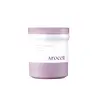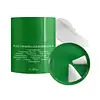What's inside
What's inside
 Key Ingredients
Key Ingredients

 Benefits
Benefits

 Concerns
Concerns

 Ingredients Side-by-side
Ingredients Side-by-side

Cetyl Ethylhexanoate
EmollientPEG-20 Glyceryl Triisostearate
EmollientSynthetic Wax
AbrasiveCaprylic/Capric Triglyceride
MaskingSorbeth-30 Tetraoleate
EmulsifyingParfum
MaskingEthylhexylglycerin
Skin ConditioningCaprylyl Glycol
EmollientWater
Skin ConditioningEclipta Prostrata Extract
Skin ConditioningMelia Azadirachta Leaf Extract
Skin ConditioningMelia Azadirachta Flower Extract
Skin ConditioningMoringa Oleifera Seed Oil
EmollientButylene Glycol
HumectantOlea Europaea Fruit Oil
MaskingCoccinia Indica Fruit Extract
Skin ConditioningAloe Barbadensis Leaf Extract
EmollientSolanum Melongena Fruit Extract
Skin Conditioning1,2-Hexanediol
Skin ConditioningCollagen Extract
Skin ConditioningSimmondsia Chinensis Seed Oil
EmollientSargassum Vulgare Extract
Skin ConditioningCurcuma Longa Root Extract
MaskingOcimum Sanctum Leaf Extract
Skin ConditioningPunica Granatum Juice Extract
Skin ConditioningNelumbo Nucifera Flower Extract
Skin ConditioningGlycerin
HumectantTocopherol
AntioxidantRosa Rugosa Callus Culture Extract
AntimicrobialWine Extract
AntioxidantRosmarinus Officinalis Leaf Extract
AntimicrobialSodium Hyaluronate
HumectantAcetyl Hexapeptide-8
HumectantLinalool
PerfumingCetyl Ethylhexanoate, PEG-20 Glyceryl Triisostearate, Synthetic Wax, Caprylic/Capric Triglyceride, Sorbeth-30 Tetraoleate, Parfum, Ethylhexylglycerin, Caprylyl Glycol, Water, Eclipta Prostrata Extract, Melia Azadirachta Leaf Extract, Melia Azadirachta Flower Extract, Moringa Oleifera Seed Oil, Butylene Glycol, Olea Europaea Fruit Oil, Coccinia Indica Fruit Extract, Aloe Barbadensis Leaf Extract, Solanum Melongena Fruit Extract, 1,2-Hexanediol, Collagen Extract, Simmondsia Chinensis Seed Oil, Sargassum Vulgare Extract, Curcuma Longa Root Extract, Ocimum Sanctum Leaf Extract, Punica Granatum Juice Extract, Nelumbo Nucifera Flower Extract, Glycerin, Tocopherol, Rosa Rugosa Callus Culture Extract, Wine Extract, Rosmarinus Officinalis Leaf Extract, Sodium Hyaluronate, Acetyl Hexapeptide-8, Linalool
 Reviews
Reviews

Ingredients Explained
These ingredients are found in both products.
Ingredients higher up in an ingredient list are typically present in a larger amount.
This ingredient is an emollient, solvent, and texture enhancer. It is considered a skin-softener by helping the skin prevent moisture loss.
It helps thicken a product's formula and makes it easier to spread by dissolving clumping compounds.
Caprylic Triglyceride is made by combining glycerin with coconut oil, forming a clear liquid.
While there is an assumption Caprylic Triglyceride can clog pores due to it being derived from coconut oil, there is no research supporting this.
Learn more about Caprylic/Capric TriglycerideCaprylyl Glycol is a humectant and emollient, meaning it attracts and preserves moisture.
It is a common ingredient in many products, especially those designed to hydrate skin. The primary benefits are retaining moisture, skin softening, and promoting a healthy skin barrier.
Though Caprylyl Glycol is an alcohol derived from fatty acids, it is not the kind that can dry out skin.
This ingredient is also used as a preservative to extend the life of products. It has slight antimicrobial properties.
Learn more about Caprylyl GlycolCetyl Ethylhexanoate is an emollient ester. It comes from cetearyl alcohol and 2-ethylhexanoic acid.
Cetyl Ethylhexanoate is an emollient that adds a velvety feel to skin without being greasy or oily. Emollients help trap moisture into your skin, keeping your skin soft and hydrated.
Ethylhexylglycerin (we can't pronounce this either) is commonly used as a preservative and skin softener. It is derived from glyceryl.
You might see Ethylhexylglycerin often paired with other preservatives such as phenoxyethanol. Ethylhexylglycerin has been found to increase the effectiveness of these other preservatives.
Peg-20 Glyceryl Triisostearate comes from Isostearic Acid and glycerin.
It is an emollient, emulsifier, and gentle cleanser. As an emollient, it helps trap moisture to keep skin soft and hydrated. Emulsifiers help prevent ingredients from separating.
This ingredient is common in oil-based products. This is because it helps oil-ingredients be easily washed away without leaving a residue.
Peg-20 Glyceryl Triisostearate may not be fungal-acne safe.
Learn more about PEG-20 Glyceryl TriisostearateSynthetic Wax is created from fossil fuels such as natural gas. It is used to enhance texture, adjust pH, and as an occlusive.
It may also be used as an abrasive ingredient to exfoliate the skin.
Synthetic Wax may not be fungal acne safe.
Learn more about Synthetic WaxWater. It's the most common cosmetic ingredient of all. You'll usually see it at the top of ingredient lists, meaning that it makes up the largest part of the product.
So why is it so popular? Water most often acts as a solvent - this means that it helps dissolve other ingredients into the formulation.
You'll also recognize water as that liquid we all need to stay alive. If you see this, drink a glass of water. Stay hydrated!
Learn more about Water